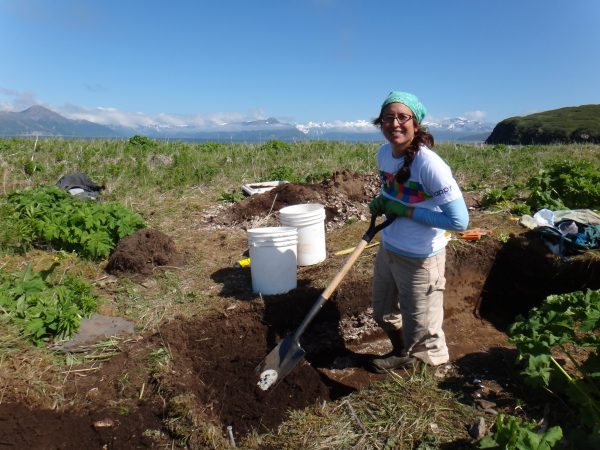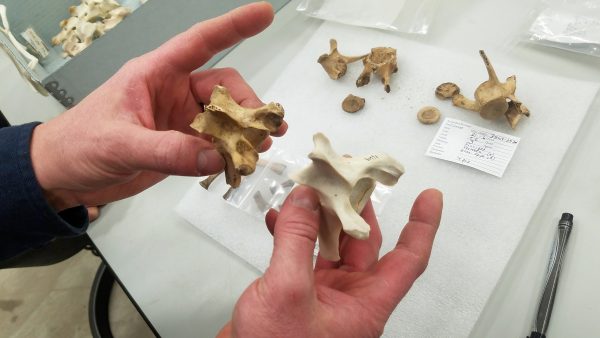Secret to ancient food webs found in old bones
February 22, 2018
Theresa Bakker
907-474-6941

Download text and photos here.
You might call Hot Springs a paradise. This remote location near Port Moller in Alaska’s Bristol Bay has it all: lush green bluffs, pristine beaches, beautiful scenery and several relaxing hot pools of water. The springs can even be used to clean dishes and clothes, if you happen to be camping there.
As it turns out, Hot Springs is also a good location for archaeological research. The site has amazing preservation properties due to the number of cockle shells that long-ago human residents tossed out with the rest of the garbage. These remains buffer the acidic soil, changing the pH to the point where bones do not disintegrate as quickly as they might in areas without access to shellfish.
From those preserved bones, scientists can extract information stored in elemental carbon and nitrogen to learn not only more about the people who ate those animals but also what animals those animals ate. Such information allows researchers to better understand the complete food web of the area from thousands of years ago.
On a recent excavation, University of Alaska Fairbanks research professor Nicole Misarti and her team of graduate students spent 5 ½ weeks at the site. It was a grand camp, but it wasn’t a wilderness experience.
“Whenever an area fishery would end, we would end up with five, six or even as many as 10 boats tied up together on the beach,” she said. “Then the hot springs would be crowded with visitors for the night. It got pretty loud.”
Clearly, an undeveloped location like this is still a popular destination by modern measures. Imagine what ancient people might have thought about it.
“This is an amazing place to study not only the culture, as they do in archaeological sites all over the world, but also the environmental history and how humans impacted ecosystems and how ecosystems shaped some of the human history, as well,” said Misarti, a research associate with the University of Alaska Museum of the North. “Hot Springs is important, as it seems to have been inhabited by large numbers of people during times when much of the rest of the Alaska Peninsula was unoccupied or thinly occupied by humans.”

Always looking for more bones
People lived at Hot Springs, on and off, from 3,500 years ago to about 500 years ago. The site was excavated in the early 1900s and again in the 1970s. But those expeditions left behind the garbage piles full of stuff not considered useful at the time. Things like animal bones.
Recently archaeologists have realized the important information stored in those biological materials, but Misarti has always been more interdisciplinary in her approach. “I am always looking for more bones,” she said.
Field notations from the earlier expeditions might have said what species were there, but before the advent of more rigorous scientific methods to make use of the bones, they wouldn’t have been collected. It was too much material — not worth the effort to bring it all back.
Misarti has degrees in environmental studies and archaeology. She also has a Ph.D. in marine science from UAF. She was working Outside before taking a job in Alaska, where she is now a research associate professor at the Water and Environmental Research Center.
After completing the Hot Springs excavation in 2014, Misarti’s team shipped out more than 50 boxes of material, now safely stored at the museum. Misarti is collaborating with a group of researchers there on a National Science Foundation-funded project to track changes in subsistence resources and material culture, the items left behind by the ancient people who lived in the Port Moller area.
At the museum, archaeology collection manager Scott Shirar is overseeing the task of sorting, identifying and quantifying those bones, a field called zooarchaeology.
After Shirar and his team sort through the bones, Misarti will look for the largest number of potential individuals from a species that she can identify. There is an art to this. She finds one particular type with the largest number of available specimens and then goes through the boxes to verify that they are all from different individuals.
Then Misarti will cut slices out of each bone and begin the long process of extracting collagen and using a variety of tools to analyze its carbon and nitrogen. The material is finally deposited on an isotope-ratio mass spectrometer, which will help her tell the story of a food web that’s thousands of years old.

You are what you eat
Now that we can analyze the proteins that make up our bodies, scientists are realizing the truth of the old adage, “You are what you eat.”
Now Misarti wants to find out what the stable isotopes of bones from the Hot Springs site say about past food webs.
Think of a food web as a directory of "who is eating whom." People study what animals are eating out in the wild and depict this as an interconnected web. Each animal is linked by a line to every animal it eats and also to every animal that eats it. This creates a visual map of not only the connections between animals but also an animal's place is within its ecosystem, Misarti said. This also leads to understanding how change in one species might affect many other species.
The more we know about change through time, the more we might know about change to come. Misarti is excited to extend the known timeline of change from a typical period of 20 or 30 years into hundreds of years ago.
“Having one site to study that was occupied at intervals over 3,500 years with really good preservation at all time periods is pretty fantastic,” she said. “What is also great is there are many collections centered around the Alaska Peninsula preserved at the UA Museum of the North, collections from coastal areas on the North Pacific and Bering Sea side of the peninsula spread over 4,000 years.”
Once those collections are fully and properly archived, with all permissions in place, Misarti said they will be an important resource. The preservation of a treasure trove of bones like this will help researchers track differences in species’ diets, behavior and geographic distribution through time as newer technologies are developed, allowing scientists to analyze data such as stable isotopes and ancient DNA.
Misarti is especially interested in testing the theory that ancient people used Hot Springs as a fallback, a place to live when salmon runs or other food supplies in the area were on the decline. “Maybe it was an easier place to make a living than at other areas,” she said.
A paradise along the Alaska Peninsula.


